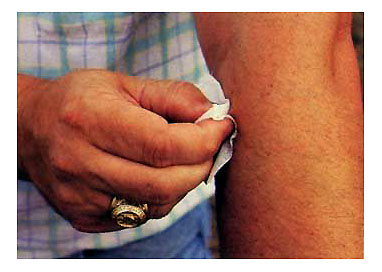How Do I Remove A Tick?
Because the movement and bites of ticks are seldom felt, careful and frequent examination of the body and clothing is imperative. Periodically inspect yourself, your children and your pets.

Use tweezers, tick removal tools or protected fingers (e.g. tissue or sanitary “baby” wipes), not your bare fingers, to remove attached ticks. Grasp the tick firmly, without crushing it, as near the skin as you can and remove it with a slow, steady pull away from your body.
Hasty removal of an attached tick can break off the mouthparts and lead to prolonged inflammation, irritation and possibly secondary infection. Treating the bite wound with first aid antiseptic will prevent secondary infection.
Tick Pathogen Testing
It is advisable to save any attached ticks you remove for identification in the event you later suspect signs of disease and contact your personal physician, medical care provider or veterinarian immediately.
Ticks can be kept alive by placing them in a small bottle with moistened (not wet) paper towel pieces; or they can be killed and preserved in a small container of rubbing alcohol or hand sanitizer.It will also help if you date the collection and note the geographic location from which the tick came. Live and alcohol preserved ticks can be submitted for examination to determine the presence of microbial pathogens.
Ticks collected from humans in Texas can be submitted directly the Texas Department of State Health Service (DSHS) for testing by the University of North Texas Health Science Center for pathogen testing services
Other states may offer similar services to their respective medical community. Check with your State Department of Health for assistance.
Please contact:
Michael S. Allen, Ph.D.
(Tel) 817-735-5038
(Fax) 817-735-5016
Email Michael.Allen@unthsc.edu at the University of North Texas Health Science Center at Fort Worth for more information on collection and shipping of tick specimens for testing.
